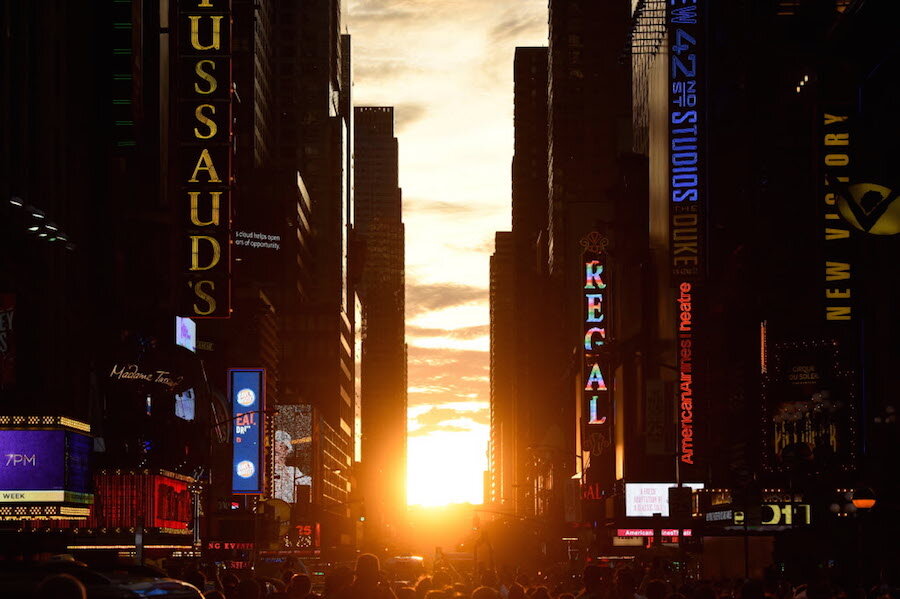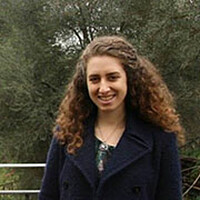Manhattanhenge marks sun's alignment with the street grid
Loading...
Manhattan will again celebrate “Manhattanhenge” on Tuesday night, as the city marvels at an astronomical event in which the sun appears to set between the skyscrapers on cross streets running east to west.
Such events and places can transform what before was merely architecture into an event with both astronomical and cultural meaning. The full Manhattanhenge occurred on May 30 and July 11 this year, two dates that are equidistant from the summer solstice. Tuesday night will see a half-sun on the horizon.
The term “Manhattanhenge” was coined by Neil deGrasse Tyson, director of the Hayden Planetarium for the American Museum of Natural History about two decades ago, according to a 2009 Science Friday segment, the connection being that the boulders of Stonehenge are aligned in the direction of the sunrise on the summer solstice and of the sunset on the winter solstice.
“Anytime you have a city mapped out on a grid, you’re pretty much going to have some alignment with a solar setting or sunrise,” Gerardo Aldana, professor of anthropology and Chicana/o studies at University of California, Santa Barbara, and editor of the Journal of Astronomy in Culture tells The Christian Science Monitor in a phone interview.
The right conditions must be present for the event to attract attention. The tall canyon-like buildings, view of the horizon across the Hudson River to New Jersey, and New Jersey’s relatively low topography all make Manhattanhenge “a unique urban phenomenon in the world, if not the universe,” writes Tyson.
But what excites scientists about Manhattanhenge is not the astronomy itself, which is a fairly straightforward matter of east-west grid alignment, but the cultural sensation that accompanies it.
"What is fascinating to me and what I love about Manhattanhenge is it brings people back to the cosmos," Jacqueline Faherty, an astronomer with the American Museum of Natural History, told The Economist in 2014. “For a little while, the sun is the star of the city.”
Celebration of Manhattanhedge reveals subtle shifts within the last century of the field devoted to studying such phenomena.
Archaeoastronomy – the study of the astronomical knowledge and practices of prehistoric cultures – can shed light on why Manhattanhenge is of such public interest. The discipline saw a turning point in the mid-20th century when it began to rely heavily on statistics and computation to calculate the physical alignment of sites with celestial bodies.
The field began to shift toward the softer sciences in the 1980s, drawing increasingly from historical and ethnographic records as well as mathematics.
Scholars now see Manhattanhenge less as a "phenomenon," searching instead for whether a city’s alignment has an “ideological connection, a cultural context, or a social organization that would be meaningful” rather than whether “the numbers line up,” Aldana says.
The change in research approach yielded new findings on how the meaning of a single place can change over time.
Anthony Aveni worked throughout the 1980s to "[push] the field away from just the numbers," Aldana says. With research about Incan astronomy in the Andes, he proved that although certain streets do not align numerically, the people who made the building plans still intended their city to have astronomical meaning.
“Whether or not it’s meaningful today is independent of what its original intent was," Aldana says. "And that’s not to say anything goes. It’s just to say that we all do this. We all make things meaningful to ourselves.”
Although synchronicity sometimes plays a role in how the sun is framed, at other times, architects have altered buildings intentionally to align with the sun. The Ryukyu Kingdom in Japan is one example. The kingdom's architecture originally lacked solar interest in its social organization or elite status, but over time the Japanese began building their castles to align with the sun. The shift is featured in the July edition of the newly open-access Journal of Astronomy in Culture.
More recently, in the early 1970s the planned community of Milton Keynes in South East England persuaded its town engineers to shift its grid of roads a few degrees to relate its city center to the rising sun on Midsummer Day, or the summer solstice, transforming what the Guardian called a “non-place” into one related, in a way, to the stars.








